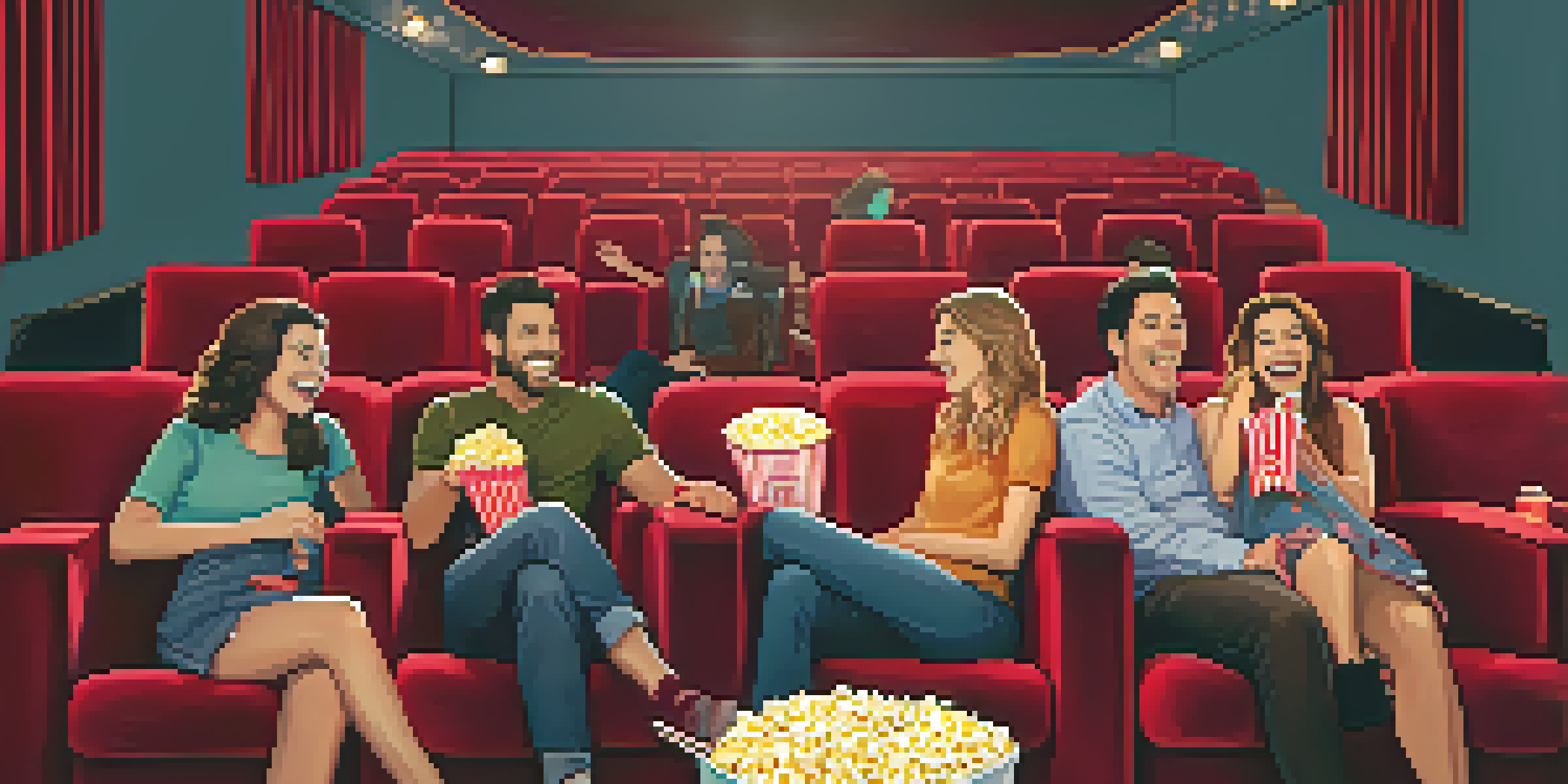The Social Aspect of Moviegoing: A Psychological Insight

The Collective Experience of Watching Movies Together
Going to the movies is often more than just watching a film; it's a shared experience. When we sit in a dark theater surrounded by others, there's a unique energy that binds us. This collective viewing fosters a sense of community, as we laugh, gasp, and react together to the story unfolding on screen.
Cinema is a matter of what's in the frame and what's out.
This shared experience can amplify our emotions, making us feel more connected to the characters and the narrative. For instance, a tense moment in a thriller can make the audience collectively hold their breath, while a comedic scene can lead to a chorus of laughter. This emotional synchronization enhances our enjoyment and creates lasting memories.
Moreover, sharing a film with friends or family can strengthen relationships. Discussing the plot twists or favorite scenes afterward often leads to deeper conversations, allowing us to bond over our interpretations and feelings about the movie.
The Role of Social Interactions in Moviegoing
Social interactions play a crucial role in the moviegoing experience. Watching a film is often accompanied by pre- or post-movie discussions, whether it’s debating the plot or sharing opinions on performances. These conversations can enhance our understanding and enjoyment of the film, making it a richer experience.

In addition, movie outings can serve as social events where friends catch up or couples enjoy a date night. The shared anticipation of seeing a film can also create excitement, making the entire outing a memorable occasion. This aspect of socialization adds another layer to why we choose to see movies in theaters rather than at home.
Shared Experiences Enhance Enjoyment
Watching movies together amplifies emotions and creates lasting memories through collective reactions and discussions.
Furthermore, the act of sharing popcorn and drinks becomes a ritual that fosters camaraderie. These little traditions contribute to a sense of belonging, making moviegoing a cherished activity for many.
Psychological Benefits of Watching Movies with Others
Watching movies with others can have significant psychological benefits. Engaging with a film in a group can lead to a greater sense of happiness and satisfaction. This communal experience can also provide comfort, as being with others during emotional or scary scenes can mitigate feelings of fear or sadness.
The magic of cinema is that it can transport you to another world, but it's the shared experience that makes it unforgettable.
Research has shown that sharing experiences can enhance our overall enjoyment and even lead to a greater emotional connection to the film. The feedback we receive from those around us—whether laughter or gasps—can validate our feelings and reactions, making us feel more understood.
Additionally, these group settings can create a safe space for vulnerability, allowing viewers to express their emotions freely. This is particularly important for films that touch on sensitive topics, as sharing those experiences can foster empathy and connection among viewers.
Cultural Influences on Moviegoing Social Norms
Cultural background plays a significant role in shaping our moviegoing habits and preferences. In some cultures, watching films is a communal event where families gather, while in others, it might be more of an individual or couple's activity. These cultural norms influence how we perceive the experience of watching a movie.
For example, in many Asian cultures, it’s common for families to go to the cinema together, reinforcing familial bonds. In contrast, in Western cultures, friends might gather to watch the latest blockbuster, highlighting the social aspects of friendship and shared interests.
Social Interactions Foster Connections
Pre- and post-movie discussions, as well as shared rituals like popcorn, strengthen relationships and enhance the overall experience.
Understanding these cultural differences can enrich our appreciation of film and the social dynamics surrounding it. It allows us to see how diverse practices can enhance the moviegoing experience, making it more inclusive and engaging.
The Impact of Technology on Moviegoing Socialization
With the rise of streaming services, the way we consume movies has transformed, affecting the social aspect of moviegoing. While streaming offers convenience, it often lacks the communal experience of watching a film in a theater with others. The shared environment of a cinema, where reactions and emotions are palpable, is difficult to replicate at home.
However, technology has also introduced new ways to socialize around films. Virtual watch parties and social media discussions allow people to connect over their favorite movies, even when they can't be together physically. This blend of traditional and modern viewing experiences creates a unique dynamic in how we engage with films.
Ultimately, while technology may change the landscape of moviegoing, it also presents opportunities for new forms of social interactions. It encourages us to explore different ways of sharing our love for films, whether in person or virtually.
The Evolution of Moviegoing as a Social Activity
The history of moviegoing reveals its evolution as a social activity. From silent films in the early 1900s to the blockbuster era, cinemas have always been gathering places for communities. Early movie theaters were often designed for large groups, reflecting the importance of shared experiences in film appreciation.
As films became more sophisticated, so did the social aspects of moviegoing. The introduction of sound and color created new opportunities for storytelling, further enhancing the communal viewing experience. Today, theaters offer luxurious seating and dining options, making the outing feel more like a special event.
Cultural Norms Shape Moviegoing
Cultural backgrounds influence how we perceive moviegoing, highlighting its communal value in diverse social contexts.
This evolution highlights how moviegoing continues to adapt to societal changes while maintaining its core value as a shared experience. It shows that no matter how much the industry changes, the social fabric of film watching remains strong.
Conclusion: The Lasting Impact of Social Moviegoing
In conclusion, the social aspect of moviegoing is deeply ingrained in our culture and psychology. The shared emotions, discussions, and experiences foster a sense of community that enhances our enjoyment of films. Whether it's a thrilling blockbuster or a heartfelt drama, sharing these moments with others can make them more impactful.
As we move forward in an increasingly digital world, it's essential to remember the value of these social interactions. Even with streaming options at our fingertips, nothing quite compares to the experience of watching a film in a packed theater, surrounded by fellow movie lovers.

Ultimately, the social aspect of moviegoing not only enriches our lives but also reinforces the connections we have with those around us. It’s a reminder that even in solitude, the stories we share can bring us together.